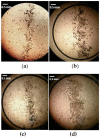Gradient Magnetic Field Accelerates Division of E. coli Nissle 1917
- PMID: 36672251
- PMCID: PMC9857180
- DOI: 10.3390/cells12020315
Gradient Magnetic Field Accelerates Division of E. coli Nissle 1917
Abstract
Cell-cycle progression is regulated by numerous intricate endogenous mechanisms, among which intracellular forces and protein motors are central players. Although it seems unlikely that it is possible to speed up this molecular machinery by applying tiny external forces to the cell, we show that magnetic forcing of magnetosensitive bacteria reduces the duration of the mitotic phase. In such bacteria, the coupling of the cell cycle to the splitting of chains of biogenic magnetic nanoparticles (BMNs) provides a biological realization of such forcing. Using a static gradient magnetic field of a special spatial configuration, in probiotic bacteria E. coli Nissle 1917, we shortened the duration of the mitotic phase and thereby accelerated cell division. Thus, focused magnetic gradient forces exerted on the BMN chains allowed us to intervene in the processes of division and growth of bacteria. The proposed magnetic-based cell division regulation strategy can improve the efficiency of microbial cell factories and medical applications of magnetosensitive bacteria.
Keywords: bacterial division; biomagnetic effects; intracellular forces; magnetic field; mitosis.
Conflict of interest statement
The authors declare no conflict of interest.
Figures












References
-
- Ayala M.R., Syrovets T., Hafner S., Zablotskii V., Dejneka A., Simmet T. Spatiotemporal Magnetic Fields Enhance Cytosolic Ca2+ Levels and Induce Actin Polymerization via Activation of Voltage-Gated Sodium Channels in Skeletal Muscle Cells. Biomaterials. 2018;163:174. doi: 10.1016/j.biomaterials.2018.02.031. - DOI - PubMed
-
- Zablotskii V., Lunov O., Novotná B., Churpita O., Trošan P., Holáň V., Syková E., Dejneka A., Kubinová Š. Down-Regulation of Adipogenesis of Mesenchymal Stem Cells by Oscillating High-Gradient Magnetic Fields and Mechanical Vibration. Appl. Phys. Lett. 2014;105:103702. doi: 10.1063/1.4895459. - DOI
Publication types
MeSH terms
LinkOut - more resources
Full Text Sources

